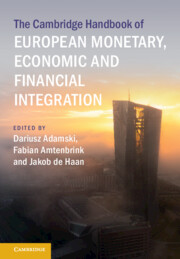Book contents
- The Cambridge Handbook of European Monetary, Economic and Financial Integration
- The Cambridge Handbook of European Monetary, Economic and Financial Integration
- Copyright page
- Contents
- Contributors
- Introduction
- Part I The Economic and Monetary Union
- Part II The Monetary Dimension
- 9 The Overburdened Monetary Policy Mandate of the ECB
- 10 Government Bond Buying by the European Central Bank
- 11 ECB Monetary Policies
- 12 From Market to Green Economics
- 13 The Politics of Monetary Union and the Democratic Legitimacy of the ECB as a Strategic Actor
- 14 How Can Courts Contribute to Accountability in EU Monetary Policy?
- Part III The Economic and Fiscal Dimensions
- Part IV Financial Integration
- Index
- References
10 - Government Bond Buying by the European Central Bank
Leadership versus Accountability
from Part II - The Monetary Dimension
Published online by Cambridge University Press: 28 September 2023
- The Cambridge Handbook of European Monetary, Economic and Financial Integration
- The Cambridge Handbook of European Monetary, Economic and Financial Integration
- Copyright page
- Contents
- Contributors
- Introduction
- Part I The Economic and Monetary Union
- Part II The Monetary Dimension
- 9 The Overburdened Monetary Policy Mandate of the ECB
- 10 Government Bond Buying by the European Central Bank
- 11 ECB Monetary Policies
- 12 From Market to Green Economics
- 13 The Politics of Monetary Union and the Democratic Legitimacy of the ECB as a Strategic Actor
- 14 How Can Courts Contribute to Accountability in EU Monetary Policy?
- Part III The Economic and Fiscal Dimensions
- Part IV Financial Integration
- Index
- References
Summary
The ECB’s government bond-buying programmes have redistributive effects that potentially constituted economic policy-making, over which the Member States retain competence. Even when ostensibly pursued in the name of price stability, the political ramifications of monetary policy became clearer and fuelled political and legal backlash against central banks in general and the ECB in particular. While the ECB took pains to restrain its policies a decade ago, it has gradually allowed itself increasing discretion with little pushback from its political principals. The minimal accountability scheme should be updated to account for the ECB’s growing role.
- Type
- Chapter
- Information
- Publisher: Cambridge University PressPrint publication year: 2023



